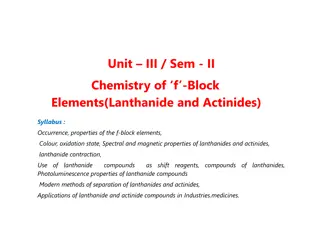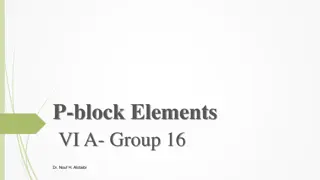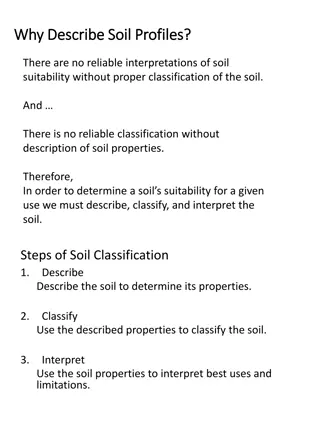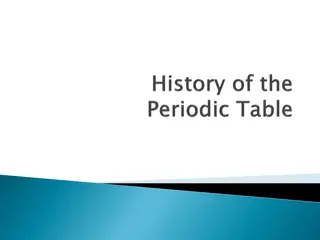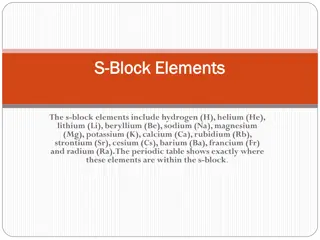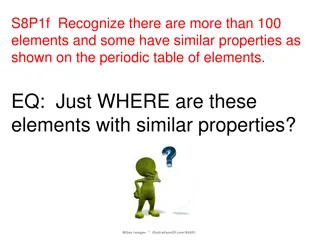Classification of Elements and Periodicity in Properties: Overview and Evolution
The journey of understanding the classification of elements and periodicity in properties begins with early laws like the Law of Triads and Newland's Law of Octaves. Mendeleev's Periodic Law revolutionized the organization of elements, leading to the modern periodic table. Discoveries of eka-aluminium and eka-silicon further enriched our understanding of elemental properties. The Periodic Law highlights analogies among elements and the division of the periodic table into s-block, p-block, d-block, and f-block. Explore the periodic table's structure and the variations in element properties across periods and groups.
Download Presentation

Please find below an Image/Link to download the presentation.
The content on the website is provided AS IS for your information and personal use only. It may not be sold, licensed, or shared on other websites without obtaining consent from the author. Download presentation by click this link. If you encounter any issues during the download, it is possible that the publisher has removed the file from their server.
E N D
Presentation Transcript
Classification of elements and periodicity in properties Chapter3
Lets recall andrevise Law of triads:- According to law of triads elements were placed in a group of 3 andthey were called triads. These were placed in the increasing order of atomic masses Newland s law of octaves:- the elements were placed in increasing order of their atomic weights and it was noted that every eighth element had properties similar to the first element . The relationship was just like every eighth note that resembles the first in octaves of music. Newlands s Law of Octaves seemed to be true to elements only upto calcium.
Mendeleevs periodiclaw The properties of theelements are a periodic function of their atomic weights. Mendeleev arranged elements in horizontal rows and vertical columns of a table in order of their increasingatomic weights in such a way that the elements with similar properties occupied the same vertical column or group .
Mendeleevleft gapsunder silicon and aluminium and those were known as eka aluminium and eka silicon. Later it was discovered that eka aluminium had properties similarto gallium and eka silicon had properties similar togermanium. According to modern periodiclaw, The physical and chemical propertiesof the elements are periodic functions of their atomicnumbers . Modern form of periodic table was discovered by henry Mosley andhence it was also called henry Mosley's periodic table.
The Periodic Law revealed important analogies among the 94 naturally occurring elements (neptunium and plutonium like actinium andprotoactinium arealsofound in pitch blende anore of uranium). The horizontalrowsof the periodic table are calledperiods while the vertical columns are called groups orfamilies.
DIVISION OF PERIODICTABLE The periodic table is divided into 4 blocks mainly the s-block p-block d- block andf-block. S-block:- Theelements of Group1(alkali metals) andGroup2(alkaline earth metals) which have ns1and ns2outermost electronic configuration belong to the s- BlockElements. They are all reactive metals with low ionization enthalpies. They lose the outermost electron(s)readilyto form 1+ion inthe caseof alkalimetalsor 2+ ionin the case of alkalineearth metals. Themetalliccharacterandthe reactivity increaseaswe go down the group. Becauseof highreactivity they areneverfound pureinnature. Thecompoundsof the s-blockelements,with the exception of those of lithium andberyllium arepredominantly ionic.
P-block: Thep-BlockElementscomprise those belonging to Group13to 18andthese together with the s-BlockElementsare called the Representative Elements or Main GroupElements. Theoutermost electronicconfigurationvariesfrom ns2np1to ns2np6ineach period. At the end of each period is a noble gas element with a closed valence shell ns2np6configuration. Allthe orbitalsin the valenceshellof the noblegasesarecompletely filled byelectronsandit isverydifficult to alterthis stablearrangement by the addition or removalof electrons. The noble gases thus exhibit very low chemical reactivity. Preceding the noble gasfamily aretwo chemicallyimportant groupsof non-metals.They arethe halogens(Group 17)andthe chalcogens(Group 16). Thesetwo groupsof elements havehighlynegativeelectrongainenthalpies andreadilyaddone or two electronsrespectivelyto attain the stablenoble gasconfiguration. Thenon-metalliccharacterincreasesaswe move from left to right acrossa period andmetalliccharacterincreasesaswe go down the group
D-block: Elements in which the d-orbitals are completely filled are calledthe d-blockelements. General electronic configuration is (n-1)d1-10ns1-2 . Properties:- -Shows catalytic properties -forms colouredions -shows paramagneticproperties -formscomplexes They are often referred to as transition metals as they are placed between metals andnon metals andalsodueto their charecteristic feature.
F-block: Elements in which the f-orbital iscompletely filled arecalled the f- block elements. General electronic configuration is ns2(n-1)d0-1(n-2)f1-10. Inner transition metalsareknown asf-block elements. Theyhaveincomplete d-orbital electronic confg in their normal state and in theiroxidation state. They are generallyradioactive.
Trends in physicalproperties We will bestudying, Atomicradius Ionicradius Ionisation enthalpy Electron gainenthalpy Electronegativity Oxidationstates Chemicalreactivity
Atomicradius The atomic size generallydecreases across a period as for the elements of the second period. It is because within the period the outer electrons are in the same valence shell and the effective nuclear increases as the atomic number increases. This results in increasedattraction between nucleus and theelectron Atomic radiusdecreasesfrom left to right as principal quantum number increases. It alsoincreasesdown a group as the numberof shellsincrease.
Variation of atomicsize to that of alkalimetals
Ionicradius The removal of an electron from an atom results in the formation of a cation,whereas gainof anelectronleadsto ananion. Acationisalwayssmallerthan itsparent atom while a anion is always greater to its parent atom. Thisisdueto electronelectronrepulsion. Isoelectronic species are thosespecies which haveTwoor morespecieswith samenumber of atoms, samenumber of valenceelectrons andsamestructure, regardlessof the nature of elementsinvolved. The cation with the greater positive charge will have a smaller radius because of the greater attraction of the electrons to the nucleus. Anion with the greater negative chargewill havethe largerradius.In this case, the net repulsion of the electrons will outweigh the nuclear charge and the ion will expand insize.
Ionisationenthalpy A quantitative measure of the tendency of an element to lose electron is given by its Ionization Enthalpy. It represents the energy required to remove anelectron from anisolated gaseous atom (X) in its ground state. In other words, the first ionization enthalpy for an element X is the enthalpy change ( i H) for the reaction X(g) X+(g)+ e Theionizationenthalpy isexpressed in unitsof kJ mol 1. We can define the second ionization enthalpy asthe energyrequired to remove the second most loosely boundelectron X+(g) X2+ (g)+ e Energyis always required to remove electrons from an atom and hence ionization enthalpies are alwayspositive. The second ionization enthalpy will be higher than the first ionization enthalpy because it is more difficult to remove an electron from a positively charged ion than from aneutral atom. In the same way the third ionization enthalpy will behigher thanthe secondandsoon.The term ionization enthalpy , if not qualified, is taken as the firstionization enthalpy.
Energy is always required toremove electrons from an atom and hence ionization enthalpies are always positive. The second ionization enthalpy will be higher than the first ionization enthalpybecauseit ismore difficult to remove an electron from a positively chargedion than from aneutralatom. In the sameway the third ionization enthalpy will be higher than the second and so on. Theterm ionization enthalpy , if not qualified, is taken as the first ionization enthalpy. We will find maxima at the noble gases which have closed electron shells and very stable electron configurations. On the other hand, minima occurat the alkalimetalsand their low ionization enthalpiescanbe correlated with their highreactivity.
Shieldingeffect In multi electron atoms , the electrons arepresent in the outermostshell and they do not experience a full positive charge hence they are shielded or screened away from thenucleus. For Eg:-in the same subshell the p-electrons will get shielded away bythes-electron as p-electron is away from the influence of nucleus and hence it s does not experience a complete positive charge!
Ionisation and atomic radius are correlated in2 ways:- (i) the attraction of electrons towards the nucleus, and (ii) the repulsion of electrons from each other. The effective nuclear chargeexperienced by a valence electron in an atom will be less than the actual charge on the nucleus because of shielding or screening of the valence electron from the nucleus by the intervening coreelectrons.
Anomalies 2s electron oflithium is shielded away. The 2selectron in lithium isshielded from the nucleus by the inner core of 1selectrons.Asaresult, the valenceelectron experiences a net positive charge which is less than the actual charge of +3. In general, shielding is effective when the orbitals in the inner shells are completely filled. This situation occurs in the case of alkali metals which have single outermost ns-electron preceded by a noble gas electronicconfiguration.
Whenwe movefrom lithium to fluorine acrossthe secondperiod, successive electrons are added to orbitals in the same principal quantum level andthe shielding of the nuclear charge by the inner core of electrons does not increase very much to compensate for the increased attraction of the electron to the nucleus. Thus, across a period, increasing nuclear charge outweighs the shielding. Consequently, the outermost electronsareheld more and more tightly and the ionization enthalpy increases across a period. As we go down a group, the outermost electron being increasingly farther from the nucleus, there is an increased shielding of the nuclear charge by the electronsin the inner levels. In this case,increasein shielding outweighs the increasingnuclear charge and the removal of the outermost electron requires less energy down agroup.
It is easier to remove 2p electron of boron than 2s electronof beryllium. The first ionisation enthalpy of boron is slightly less thanberyllium though the former hasagreater nuclear charge. Whenwe consider the same principal quantum level, an s-electron is attracted to the nucleus more than ap-electron. In beryllium, the electron removed during the ionization is an s- electron whereas the electron removed during ionization of boron is ap-electron. Thepenetration of a2s-electronto the nucleus ismore than that of a 2p-electron; hencethe 2pelectron of boron ismore shielded from the nucleus by the inner core of electrons than the 2s electrons of beryllium. Therefore, it is easier to remove the 2p-electron from boron comparedto the removalof a2s-electron from beryllium.Thus, boron hasasmallerfirst ionization enthalpy than beryllium
First ionisation enthalpy of oxygen is less thannitrogen. The smaller first ionization enthalpy of oxygen compared to nitrogen. This arises because in the nitrogen atom, three 2p- electronsresidein different atomic orbitals (Hund s rule) whereas in the oxygen atom,two of the four 2p-electrons must occupythe same 2p-orbital resulting in an increased electron-electron repulsion. Consequently, it is easier to remove the fourth 2p- electron from oxygen than it is, to remove one of the three 2 p- electrons fromnitrogen.
Givereasons Why are lanthanides and actinides placed separately at the bottom of the periodic table ? (a) For convenience and systematic study of elements having similar properties. (b) To maintain the structure of periodic table of classification by keeping elements with similar properties in a similar way. Elements like Zn , Pd, Cd are not considered transition elements ? (a) As they have incompletely filled d-orbitals Chemistry of Actinoids is complicated why ? As they show large no of oxidation states
Electron gainenthalpy when an electron is added to a neutral gaseous atom (X) to convert it into a negative ion, the enthalpy change accompanying the process isdefined asthe Electron Gain Enthalpy( egH). Electron gain enthalpy provides ameasure of the easewith which anatom adds an electron to formanion X(g)+e X (g) Depending on the element,the process of adding anelectron to the atom canbe either endothermic orexothermic Added to the atom and the electron gain enthalpy isnegative. Forexample, group 17 elements (the halogens) have very high negative electron gain enthalpies becausethey canattain stable noble gaselectronic configurations bypicking up an electron On the other hand, noble gases have large positive electron gain enthalpies becausethe electron hasto enter the next higher principal quantum level leading to a very unstable electronic configuration. It may be noted that electron gain enthalpies havelarge negative valuestoward the upper right of the periodic table preceding the noble gases.
As a general rule, electron gain enthalpy becomes morenegative with increase in the atomic number across a period. The effective nuclear charge increasesfrom left to right across a period and consequently it will be easier to add an electron to a smaller atom since the added electron on an average would be closer to the positively charged nucleus. We should also expect electron gain enthalpy tobecome less negative as we go down a group because the size of the atom increases and the added electron would be farther from the nucleus
electronegativity A qualitative measureof the ability of anatom in a chemical compound to attract shared electrons to itself is called electronegativity. Flourine has the highest electronegativityvalue of 4. It is the most electronegative element.
Non-metallic elements have strong tendency to gain electrons. Therefore, electronegativity isdirectly related to that non-metallic properties ofelements. It can be further extended to say that the electronegativity is inversely related to the metallic properties of elements.Thus,the increase in electronegativities across a period is accompanied by an increase in non-metallic properties (or decrease in metallic properties) ofelements. Similarly, the decrease in electronegativity down a group is accompanied by adecreasein non-metallic properties (or increase in metallic properties) of elements.
Oxidationstate The valence equals to the number of electrons present inthe outermostshell. The term oxidation state interchangeably meansvalence. Fluorine has the oxidation state of -1 but in compounds like OF2 it exhibits +2 oxidationstate. Oxidation state determines the oxidation number of theelement.
Chemicalreactivity Diagonal relationship refers to the relationship between certain pairs of diagonally adjacent elements in the second and in the 3rd period respectively. Thischaracteristicproperty isshown by s-andp-blocks respectively.
he anomalous behaviour is attributed to their small size, large charge/radiusratio andhigh electronegativity of the elements. In addition, the first memberof group hasonly four valenceorbitals (2sand 2p) available for bonding, whereas the secondmemberof the groups havenine valenceorbitals (3s,3p,3d). As a consequence of this, the maximum covalency of the first member of each group is 4 (e.g., boron can only form [BF4 ] , whereas the other members of the groups can expand their valenceshell to accommodatemore than four pairsof electrons e.g., aluminium forms [AlF6 ]3-. Furthermore, the first member of p-block elements displays greater ability to form p p multiple bonds to itself (e.g. C=C,C C,N=N,N ) andto other secondperiod elements (e.g.,C =O,C=N,C N,N=O)compared to subsequent membersof the samegroup.
Metallic character decreases from right to leftwhereas non metallic character increases from left toright. This is due to addition of electrons in variousorbitals. Elements which combine on the two extremes of theperiodic table form oxides like peroxides and superoxides. Some are acidic basic and neutral or bette rknown as amphoteric oxides Metals from basic oxides , non metal form acidicoxides. Among transition metals (3d series), the change in atomic radii is much smaller as compared to those of representative elements acrossthe period. Thechange in atomic radii isstill smalleramong inner-transition metals (4f series). The ionization enthalpies are intermediate between those of s-andp-blocks.Asaconsequence, they arelesselectropositive than group 1and2metals.




